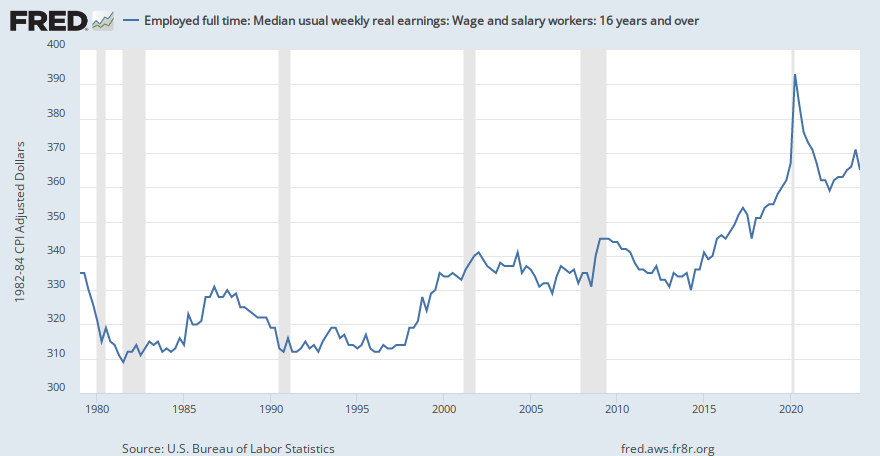- Joined
- Jun 14, 2019
- Messages
- 1,333
- Reaction score
- 732
- Gender
- Female
- Political Leaning
- Very Liberal
I keep hearing that wages aren't keeping up with inflation. No doubt that's true, but it doesn't automatically mean what people think it does. Real wages often rise during recessions then fall during the subsequent recovery.
That sounds counter-intuitive, but it makes sense when you look at the kinds of moves employers actually make in response to the start and end of a period of economic turmoil. When a recession starts, they often stop hiring new entry-level workers, hoping to "right size" through attrition. If a hiring freeze doesn't prove to be enough, they'll fire people, but that disproportionately hits lower-level workers. Unions, for example, tend to have last-in/first-out rules, which make sure it's the cheapest workers who get cut. Even outside that setting, companies are usually more comfortable going lean on the bottom rungs, where they can quickly staff up when the recovery comes, rather than losing "institutional knowledge" by cutting more senior workers. Plus, if you have 90 workers doing occasional overtime to get the job done, where you used to have 100 workers and no overtime, the median worker will be earning more.
You can see that in a graph of median real weekly earnings around the 2008 recession (with the recession in gray):

By the end of the recession, median workers were making far more than before the recession. And then, during the subsequent recovery, real wages fell (as junior positions were staffed up again, moving medians down).
The pandemic did the same thing, but much more dramatically. At the end of 2019, median weekly earnings were $362 (in 82-84 dollars). By second quarter, they were up to $393. That's about 8.6% increase in just six months, even as unemployment rates rose from 3.6% to 14.7%! And, of course, once the economy was recovering, real incomes fell again -- currently steady at $362... right where they were at the end of 2019.
So, it's not necessarily that inflation is eroding paychecks in real terms. A median worker today is earning just what a median worker was earning, per week, before the pandemic hit, after adjusting for inflation.... with the same unemployment rate. Real wages soared and then fell, but that seems to have been almost entirely the result of firing then rehiring disproportionately junior workers. Now that we're back to the previous unemployment level, we're also back to the previous real wage level.
That sounds counter-intuitive, but it makes sense when you look at the kinds of moves employers actually make in response to the start and end of a period of economic turmoil. When a recession starts, they often stop hiring new entry-level workers, hoping to "right size" through attrition. If a hiring freeze doesn't prove to be enough, they'll fire people, but that disproportionately hits lower-level workers. Unions, for example, tend to have last-in/first-out rules, which make sure it's the cheapest workers who get cut. Even outside that setting, companies are usually more comfortable going lean on the bottom rungs, where they can quickly staff up when the recovery comes, rather than losing "institutional knowledge" by cutting more senior workers. Plus, if you have 90 workers doing occasional overtime to get the job done, where you used to have 100 workers and no overtime, the median worker will be earning more.
You can see that in a graph of median real weekly earnings around the 2008 recession (with the recession in gray):

By the end of the recession, median workers were making far more than before the recession. And then, during the subsequent recovery, real wages fell (as junior positions were staffed up again, moving medians down).
The pandemic did the same thing, but much more dramatically. At the end of 2019, median weekly earnings were $362 (in 82-84 dollars). By second quarter, they were up to $393. That's about 8.6% increase in just six months, even as unemployment rates rose from 3.6% to 14.7%! And, of course, once the economy was recovering, real incomes fell again -- currently steady at $362... right where they were at the end of 2019.
So, it's not necessarily that inflation is eroding paychecks in real terms. A median worker today is earning just what a median worker was earning, per week, before the pandemic hit, after adjusting for inflation.... with the same unemployment rate. Real wages soared and then fell, but that seems to have been almost entirely the result of firing then rehiring disproportionately junior workers. Now that we're back to the previous unemployment level, we're also back to the previous real wage level.





